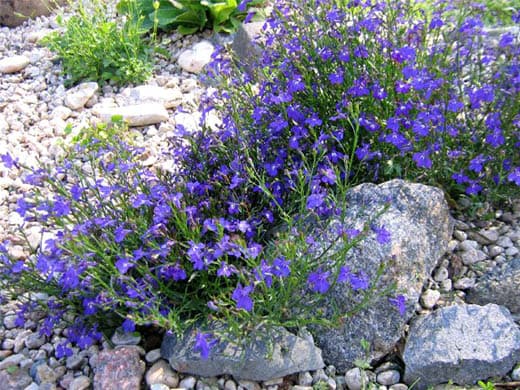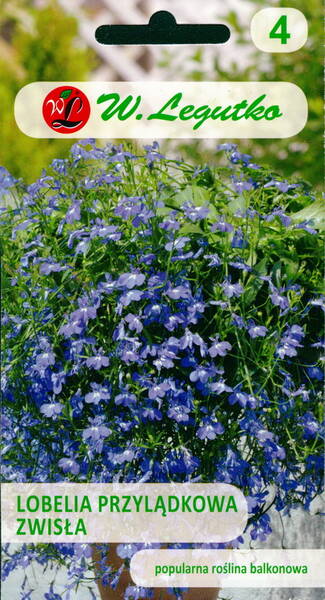Ideal for baskets and containers.
A perennial plant used as an annual in our cool climates.
A beautiful herb with hanging shoots (up to 30 cm long), covered with blue inflorescences.
Blooms from June to September. 1,0 g = 50000 seeds.

Brief botanical characteristics of Lobelia erinus.
Homeland - South Africa (Cape Province).
Stems are thin, strongly branching from the base, densely leafy. Bushes are compact, spherical, 10-25 cm tall. The leaves are arranged in the next order, small, lanceolate, whole. Flowers up to 2 cm in diameter, two-lipped, on short pedicels, one in the axils of the leaves.
Coloring - from blue to dark blue, violet-blue, purple or white, depending on the variety.
Blooms from June to September (blooms 70-80 days after sowing). The duration and abundance of flowering increase with the timely removal of faded stems.
Bears abundantly. The fruit is a lot of seed capsule. The seeds are very small (about 50,000 seeds per 1 g), viable for 3 years.
In culture since 1861.
The main species has three garden forms: climbing (f. pendula) - with profusely flowering, hanging shoots 30-35 cm long.
Used as ampelous, good in vases; erect (f. erecta) - columnar bush up to 25 cm tall; compact (f. compacta) - dense, round bush, 10-15 cm tall.
Location: this is a heat-loving and light-loving plant, but it can also tolerate partial shade.
Soil: Lobelia grows well on loose, loamy or sandy loamy soils. Does not tolerate excess organic fertilizers.
Care: for a lush and long flowering, she needs periodic feeding and abundant watering in dry weather. On too fatty soils fertilized with organic substances, lobelia stretches out, forms a mass of leaves and blooms poorly. After the first wave of flowering, the plants are cut at a height of 5 cm. After that, they form shoots again, and the second wave of flowering begins. When caring for lobelia, you should pay attention to watering: when the root ball dries, its stems bend.
Diseases and pests have not been identified.
Reproduction: seedling method.
Seeds for seedlings are sown in February-March. Seedlings appear together 10-15 days after sowing. Seedlings are so small that they dive not earlier than a month after emergence and several plants together. After 12-15 days, the seedlings are fed with complex fertilizer.
They are planted in open ground from mid-May at a distance of 10-15 cm from each other. When the plants reach 2.5 cm in height, you can pinch the tops for better tillering (well-seasoned seedlings can withstand frosts down to minus 1-2 °C).
Usage: lobelias are good in borders, ridges, groups and arrays on the lawn, in garden vases and balcony boxes.
Ampel varieties are good in hanging baskets and pots.
Partners: Lobelia goes well with dwarf pelargoniums, salvia and mimulus.

Marty Bell.
Eng.: Edging lobelia, fountains lobelia. Bot. syn.: Lobelia erinoides L.












